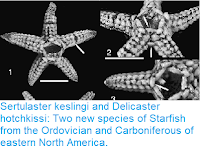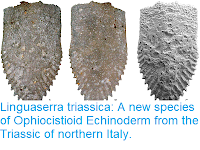Sea Cucumbers (Holothuroidea) are a class of Echinoderms that have
become elongated and worm-like, effectively becoming secondarily
bilaterally symmetrical. Like all Echinoderms they have a calcareous
exoskeleton, but this is greatly reduced, typically only occurring as
ossicles within the epidermis. The muscle structure of Sea Cucumbers is
instead supported by a layer of modified collegen that can be stiffened
or relaxed at will, allowing for a more flexible body than that of other
Echinoderms.
In a paper published in the journal ZooKeys on 15 January 2018, Francisco Alonso Solís-Marín of the Colección Nacional de Equinodermos 'Dra. Ma. Elena Caso Muñoz' at the Universidad Nacional Autónoma de México, Carlos Andrés Conejeros-Vargas of Posgrado en Ciencias del Mar y Limnología at the Universidad Nacional Autónoma de México, Andrea Alejandra Caballero-Ochoa of the Facultad de Ciencias at the Universidad Nacional Autónoma de México, and Julio Adrian Arriaga-Ochoa, also of Posgrado en Ciencias del Mar y Limnología at the Universidad Nacional Autónoma de México, describe a new species of Sea Cucumber from Acapulco Bay on the Pacific Coast of Guerrero State, Mexico.
The new species is placed in the genus Epitomapta, which currently contains two species of small, worm-like Sea Cucumbers from the Atlantic Coast of the United States and the Pacific Coast of Mexico, and given the specific name simentalae, in honour of Delia Rosalba Simental Crespo, for her contributions to the study and conservation of Echinoderms on the coasts of Mexico. The species is described from 127 specimens collected from well aerated sandy sediments at depths of between four and ten meters. These specimens are pink to light purple in colour and less than 2 cm long, with smooth skin and twelve tentacles, each with two or three pairs of digits and a terminal digit, plus up to six sensory cups.
Epitomapta simentalae. Lateral view of preserved specimen. Solís-Marín et al. (2019).
See also...
Follow Sciency Thoughts on Facebook.







